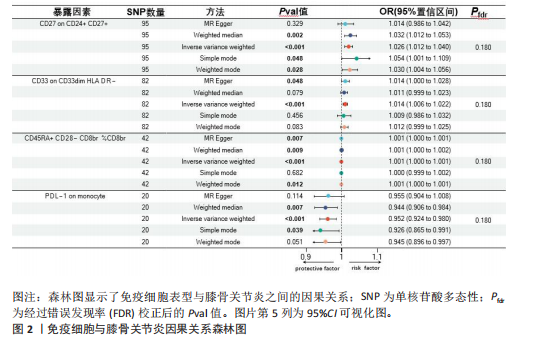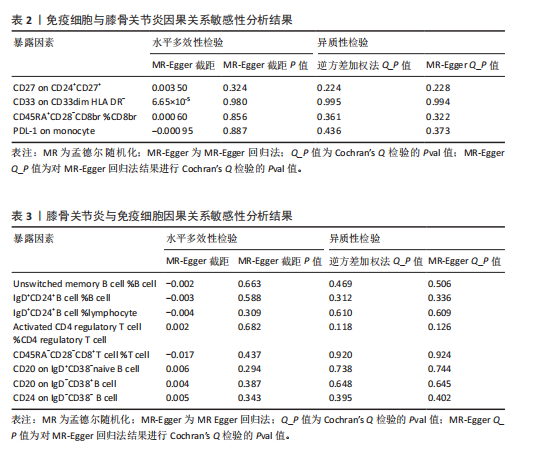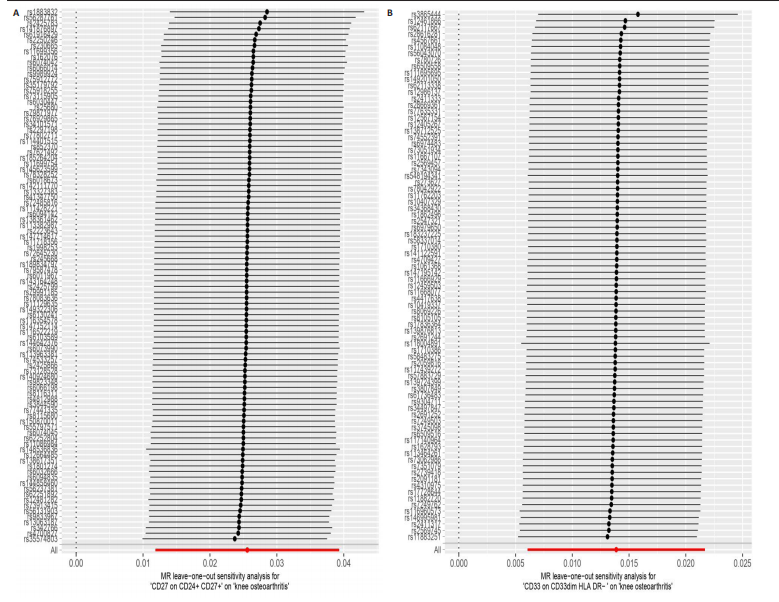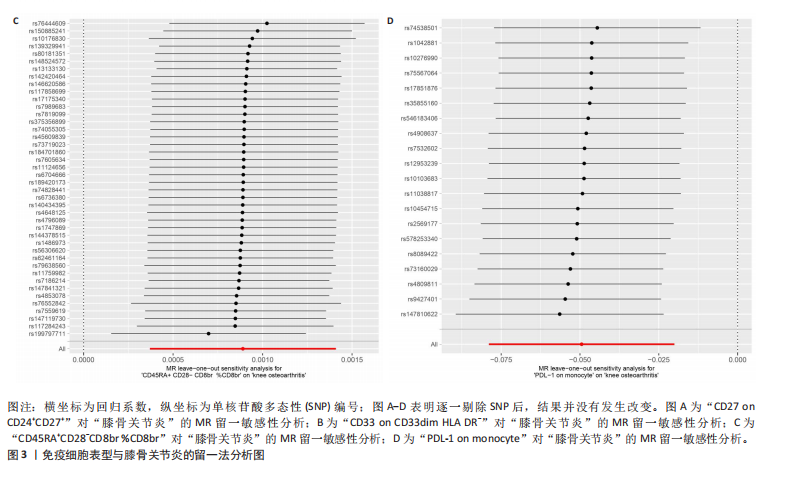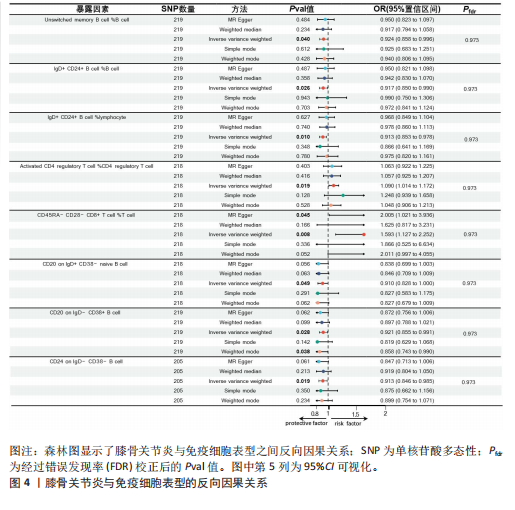膝骨关节炎是一种常见的关节软骨及周围组织损伤的慢性炎症性疾病,病程比较漫长,但目前并未发现且最终被证明可以干预性改变骨关节炎疾病进展的治疗药物及方法。随着膝骨关节炎免疫机制的面纱被逐渐揭开,大量的免疫细胞被发现与膝骨关节炎的免疫炎症反应息息相关[6],但其中的具体机制仍有待深入研究。探究免疫细胞与膝骨关节炎之间的因果关系对于疾病相关的早期防治及干预性药物至关重要。
随着全基因组关联研究的不断发展,孟德尔随机化分析方法广泛应用于各种因果关系的评估。遗传变异是遗传编码的一部分,存在于个体之间的差异。由于每个个体的遗传密码在出生前就已确定,因此任何可测量的变量在成人中出现的先后顺序不可能早于遗传变异,并且不受周围环境的影响。这使得在评估可改变的暴露因素与临床结果之间的因果关系时,可以减少混杂因素引起的偏差,而因果关系的论证强度也因此比传统观察性研究更可靠,类似于一项自然随机对照试验[32]。文章通过公开的大量遗传数据,首次对731种免疫细胞表型与膝骨关节炎之间的因果关系进行了全面的两样本双向孟德尔随机化分析,相较于传统的单个或几个免疫细胞对膝骨关节炎的双盲对照试验而言,样本量更大,采用分析方法更具有针对性,而在实验中采用错误发现率对逆方差加权法P值进一步进行校正及筛选,对因果关系的论证强度更加高。
研究结果显示,在免疫细胞表型作暴露因素,膝骨关节炎作为结局数据时,共有4种免疫细胞表型对膝骨关节炎有显著的因果关系,其中膝骨关节炎的风险随着B细胞组中的CD27 on CD24+CD27+表型、髓源性细胞组中髓源性抑制细胞的CD33 on CD33dim HLA DR-表型以及Treg细胞组中的CD45RA+CD28-CD8br %CD8br表型含量增加而升高,而单核细胞组中PDL-1 on monocyte表型的增加反而会导致膝骨关节炎风险的降低。而在膝骨关节炎作为暴露因素,免疫细胞表型作作为结局数据时,并未发现对731种免疫细胞表型具有显著因果关系的膝骨关节炎数据。
在此次研究结果中,B细胞组的CD27 on CD24+CD27+表型与骨关节炎风险增加存在显著因果关系。当B细胞表面阳性表达CD24及CD27时,则被称为CD24+CD27+ B淋巴细胞。B淋巴细胞是来源于骨髓的多能干细胞,由受体-抗原相互作用在生发中心内激活,其中包括B细胞表面受体对致病抗原的特异性识别以及与抗原特异性T细胞的相互作用,通过克隆扩增和分化为产生抗体的浆细胞或长寿命记忆B细胞而参与骨关节炎中的免疫应答[33]。BURT等[34]的研究证明,骨关节炎患者B淋巴细胞大量浸润于滑膜组织,浸润程度与滑膜炎症及浆细胞和淋巴滤泡的存在有关,且B细胞扩增和分化为浆细胞的能力在骨关节炎中发生改变。CD24又称热稳定抗原,是一种高度糖基化的糖基磷脂酰肌醇锚定表面蛋白,表达在B细胞发育的多个阶段,包括从骨髓的前B细胞开始,到分化成熟的B细胞表面均有表达,与先天免疫细胞上的Siglec-10相互作用,主要作用于B细胞和某些肿瘤细胞表面,以抑制响应感染、败血症、肝损伤和慢性移植物抗宿主疾病的破坏性炎症反应[35]。CD27也称为肿瘤坏死因子RSF7,属于肿瘤坏死因子超家族的一员[36],在幼稚T细胞、记忆B细胞、NK细胞、造血干细胞和祖细胞上均存在结构性表达。OFLAZOGLU等[37]发现,阻断CD27/CD70与抗CD70抗体的相互作用可减少胶原诱导关节炎小鼠关节中的骨和软骨侵蚀和炎症浸润,减少胶原特异性抗体的产生。后来CD27在免疫机制方面的研究表明[38],CD27与其配体CD70的相互作用可以向T细胞提供信号以控制其累积和反应。HUANG等[39]的生物信息学差异分析发现,CD27是类风湿性关节炎和骨关节炎共有的核心基因,且在类风湿性关节炎患者的滑液中,可溶性CD27水平和CD27 T细胞数量升高,并与类风湿因子水平相关,支撑CD27+在类风湿性关节炎中的作用。在另一骨关节炎的研究中,CD27阳性表达的B细胞亚群具有免疫调节功能,是分泌白细胞介素10的主要B细胞类型,对比骨关节炎早期患者而言,晚期骨关节炎患者白细胞介素10在滑膜上的分泌量显著增加[40]。以上多个研究表明,软骨及滑膜等骨关节炎组织的炎性损伤与CD27阳性表达的B细胞亚型高表达有关,这与文章的结果方向一致,但在膝骨关节炎中的免疫机制还有待更加深入的研究。
此研究结果表明,髓源性细胞组中髓源性抑制细胞的CD33 on CD33dim HLA DR-表型与骨关节炎风险增加存在显著因果关系。髓源性抑制细胞被广泛描述为具有强大免疫抑制活性的髓系祖细胞和未成熟髓系细胞的异质性群体,被证明参与感染、自身免疫性疾病和衰老相关的急、慢性炎症过程[41]。近几年的一些研究发现,髓源性抑制细胞在破骨细胞分化过程中被代谢重组,而在与骨破坏相关并发症的病理条件下,可以作为破骨细胞祖细胞发挥作用[42],还可以通过诱导软骨下骨重塑引发代谢性骨关节炎[43]。
CD33属于整合素家族的一员,作为抗原标志物在人髓系细胞表面表达,通常存在于早期造血细胞和成熟白细胞,比如粒细胞和单核细胞,可在某些浆细胞性骨髓瘤上异常表达,常用于急性髓系白血病的诊断,在超过80%的急性髓系白血病患者中CD33异常表达[44]。一项急性髓系白血病的病例报告指出,患者在确诊前一年内,双侧颞下颌关节疼痛进行性加重,通过免疫组化染色显示骨髓间隙中CD33异常表达[45]。说明CD33的异常表达会引起人体特殊免疫应答而作用于人体关节,其中具体免疫机制还有待研究。HLA DR是主要组织相容性复合体(MHC)的其中一个等位基因,属于人类白细胞抗原(HLA)系统,由6号染色体区域6P21上的人类白细胞抗原复合物编码,这种抗原能够呈递抗原片段给T细胞,尤其是辅助CD4+ T细胞,从而产生相应的免疫应答[46]。研究表明,对比健康组而言,骨关节炎组的HLA DR家族基因异常表达[47]。目前尚未有髓源性抑制细胞CD33 on CD33dim HLA DR-表型在膝骨关节炎中的研究报道,但通过髓源性抑制细胞、CD33以及HLA DR表型的研究可以推测,因此CD33 on CD33dim HLA DR-对膝骨关节炎风险的显著因果关系,除了CD33参与的免疫作用,还可能是HLA DR阴性表达导致的间接免疫作用造成的,其中的潜在机制还需针对性设计相关实验作进一步探索。
结果显示Treg组中的CD45RA+ CD28-CD8br %CD8br表型骨关节炎风险增加存在显著因果关系。T细胞可分为3个亚群:辅助性T细胞、细胞毒性T细胞和Treg。Treg是其中一种具有拮抗作用的T细胞亚群,在维持免疫平衡中起重要作用[48]。在一项骨关节炎研究中发现骨关节炎的进展与外周血中辅助性T细胞17(Th17)/Treg细胞比例失衡有关[49]。CD8br指的是CD8bright,属于CD8+ T细胞的一种。当CD8+ T细胞在受到缺氧和炎症刺激时,会加剧膝骨关节炎的进展。研究发现CD8+ T淋巴细胞可通过激活环鸟苷酸-腺苷酸合成酶(cGAS)和干扰素基因刺激因子(STING)通路[50],从而诱发炎症反应和促进软骨细胞衰老、凋亡和细胞外基质的降解,加速骨关节炎进展。ZHU等[12]研究结果表明,相较正常组而言,骨关节炎患者的CD8+CD45RA- T细胞表达增加,而CD8+CD45RA+ T细胞较少,说明CD45 RA在T细胞的表达是骨关节炎免疫机制中的一环。JEONG等[51]发现,CD8+CD27-CD28-T通过表达趋化因子样受体1参与骨关节炎的炎症反应。虽然不少研究表明CD45RA,CD28以及CD8br通过在T细胞上不同程度的表达参与骨关节炎的免疫机制,这些研究也在一定程度上支持了文章的研究结果,但尚未有CD45RA+CD28-CD8br %CD8br表型在膝骨关节炎领域较为详细的研究报道,其中的具体机制还有待探索。
文章的结果还揭示了属于单核细胞的PDL-1 on monocyte表型与骨关节炎风险降低存在显著因果关系。单核细胞分为经典、非经典和中间3个亚群,在先天免疫系统中起着至关重要的作用。在膝骨关节炎患者中,滑液里的中间单核细胞水平升高,与膝关节损伤程度、膝功能评分(KOOS)以及WOMAC功能指数评分具有相关性[52],此外,骨关节炎滑液可通过调节细胞因子的单核细胞分化途径在体外增加破骨细胞生成。PDL-1也被称为程序性细胞死亡配体1,可与程序性细胞死亡蛋白1(PD-1)结合,通过阻断磷酸化信号、调节T细胞功能在免疫耐受和抑制中起关键作用,可以在造血细胞和非造血细胞中检测出[53]。在临床中,PD-1/PDL-1的阻断是通过PD-1或PDL-1抗体进行的,这些抗体可以抑制配体和受体之间的相互作用,可以增强抗癌T细胞免疫功能并增加几种人类癌症的总生存期[54]。LIU等[55]的研究表明阻断PDL-1后,膝骨关节炎小鼠滑液和血清中的白细胞介素6和肿瘤坏死因子α的水平因PDL-1阻断而升高,导致膝骨关节炎软骨损伤加重。说明PDL-1对膝骨关节炎是一种保护因素,这与文章的研究结果不谋而合。而在表达PDL-1的单核细胞中对膝骨关节炎起保护作用的免疫机制具体通过何种方式进行还有待更进一步的研究。
此外,文章为了对正向结果进行验证,也为了探索膝骨关节炎对免疫细胞的潜在因果关系,进行了反向孟德尔随机化分析。结果显示,当膝骨关节炎作为暴露数据时,与731种免疫细胞表型均不具有显著因果关系。孟德尔随机化利用单核苷酸多态性作为工具变量来推断所研究的暴露因素对结局因素的因果关系,而遗传变异发生在疾病之前,注定两者的顺序无法逆转[14],因此,孟德尔随机化分析也可以避免反向因果关系的干扰。根据孟德尔随机化分析方法的这一特性,反向孟德尔随机化分析在另一角度来说,也是对正向结果的一种验证,反向孟德尔随机化阴性结果恰恰证明了在正向分析中,免疫细胞对膝骨关节炎的显著因果关系并未受到反向因果关系的影响而产生假阳性。而此次反向孟德尔随机化阴性结果,也可能是文章方法的局限性及所选用的膝骨关节炎全基因关联组数据样本偏差等因素导致的,还需作进一步作深入研究。文章也属于观察性研究的一种,仍十分有必要针对膝骨关节炎对免疫细胞的潜在因果关系进行更加深入的探索以寻找中间存在的作用机制。
文章也具有一定局限性:首先,因731种免疫细胞表型的全基因关联组数据是对欧洲人群进行研究的,为避免两种数据人群不同所带来的实验偏差,相应的膝骨关节炎全基因关联组数据也均来源于欧洲人群的研究,而其他人群是否存在相似遗传变异、此次研究结果是否适用于其他人群,仍需进一步研究;其次,文章未能考察免疫细胞表型之间的交互作用,可能存在联合效应,不能排除其对结果的影响程度;最后,虽然在反向孟德尔随机化分析中,膝骨关节炎数据对免疫细胞表型的因果关系并不显著,但是不能排除是研究方法局限性及样本偏差所致,两者顺序上依然存在具有潜在的因果关系,此结果仍能为膝骨关节炎对免疫表型的因果关系的下一步研究提供有用信息。总之,未来需要纳入更多不同的人群、更多的病例数及样本量以及采用更为先进的实验方案和统计学方法对免疫细胞之间、免疫细胞与膝骨关节炎之间的关联机制的进行研究。
综上,文章区别于对单个或者多个免疫细胞对膝骨关节炎的传统观察性研究,采用基于SNPs作为工具变量的孟德尔随机化分析方法,探索了731种免疫表型与膝骨关节炎之间的因果关系,降低了混杂因素、反向因果关系和其他因素岁结果的影响。结果发现4种免疫细胞表型对膝骨关节炎具有显著因果关系。根据此次研究结果及目前的多种免疫细胞的研究结果,文章推测:这4种免疫细胞表型可能通过在不同免疫细胞上不同程度的表达来影响相应的免疫细胞功能,从而造成产生不同的保护或者致险作用。而在反向孟德尔随机化结果中未发现对免疫细胞具有显著因果关系的膝骨关节炎数据,可能与研究方法及样本偏差有关,仍需深入研究。此结果可能适用于临床对膝骨关节炎免疫方面的诊断及靶向治疗药物的研究,对膝骨关节炎早期诊段和治疗策略具有积极意义。而在正向孟德尔随机化结果中,仅有部分免疫细胞表型在膝骨关节炎方面的免疫作用已被研究,尚未研究免疫细胞或已有初步研究的免疫细胞在膝骨关节炎中的免疫机制都需要针对性地设计科学实验作深入探索。文章为后续探索免疫细胞与膝骨关节炎之间的关联打下基础,有利于深入研究人体免疫系统与膝骨关节炎之间的关系,也为膝骨关节炎免疫方面的特异性诊断标志物及干预性药物的研究提供有价值的线索。
中国组织工程研究杂志出版内容重点:组织构建;骨细胞;软骨细胞;细胞培养;成纤维细胞;血管内皮细胞;骨质疏松;组织工程
